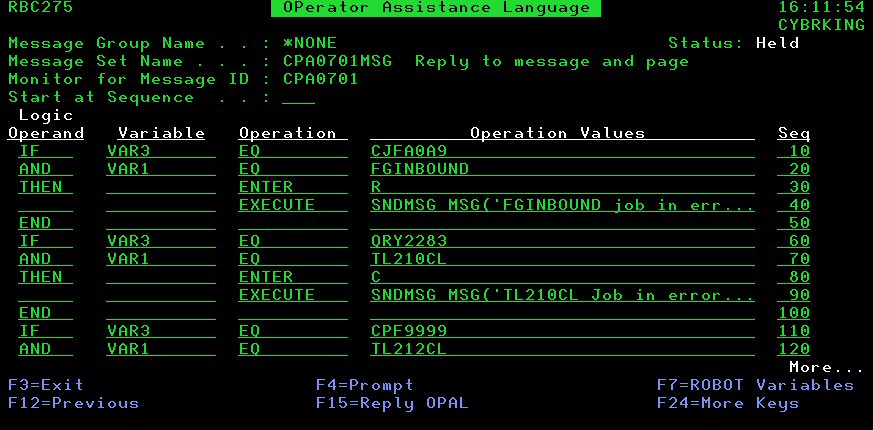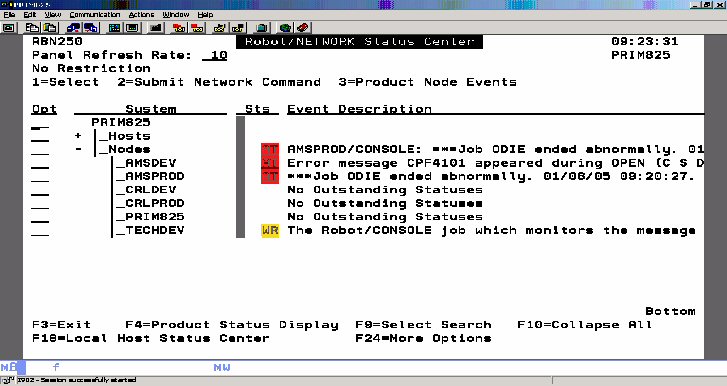Do you monitor the QSYSOPR message queue manually? Do you need to automate save-while-active message queue processes? Do you need to develop a consistent list of responses to messages in your system's message queues? Do you want to consolidate your console workstations?
Management by exception is a key component of automated operations. The idea is to suppress unimportant events and concentrate on those events that require attention. This is extremely hard to do in manual mode. If your operators manually monitor your main system message queues, management by exception becomes an impossible ideal.
So how can you automate iSeries messages? The RCVMSG command allows you to read a message queue in real-time. When a message arrives, your program wakes up, and you can read the message and execute the required command. In newer releases of i5/OS and OS/400, you can even use APIs to read the message queue. These APIs are documented, with examples, in the IBM Information Center under Programming. Your programmers can write CLPs to read, respond to, and execute commands to automate your processing. But is that what you want your programmers doing?
Another option is to use OS/400's Message Reply List Table. The WRKRPYLE command allows you to access the table and enter the default replies to execute when an inquiry message arrives on a message queue. Inquiry messages (messages that expect a reply) encompass many common messages, including File full, Array index error, and Call to program ended in error. Your team can specify exact replies to messages that you want answered the same way every time. Unfortunately, this option lacks flexibility.
Robot/CONSOLE, Help/Systems' message management and resource monitoring software, provides automation to effectively achieve management by exception on every system or partition--without programming. It focuses on automating message events at the source of the problem. Rules are applied to suppress unimportant messages, change message color, auto answer common messages, call programs, execute commands, make a message response-required, and escalate the message.
One of Robot/CONSOLE's most powerful features is OPerator Assistant Language (OPAL), an operations language that allows you to duplicate what an operator would do when a message arrives. OPAL allows for automation that is limited only by your imagination. For example, you can easily handle the following situations:
Respond differently depending on which file is full.

Figure 1: OPAL code allows you to specify exactly how a message should be handled. (Click images to enlarge.)
If you manage multiple instances of i5/OS or OS/400, you're probably interested in console consolidation. For many data centers, console consolidation consists of constructing a command center or "war room" equipped with stackable monitor-housing units, slide-out keyboard trays, toggle switches, and large-screen monitors. They look impressive, but they lack automation. The goal is to reduce the number of consoles you use to manage the systems. It's not unrealistic to have 50 or more systems or partitions reporting into one console.
Robot/CONSOLE is very good at managing numerous systems by exception. It works with our networking software, Robot/NETWORK, which provides the conduit for consolidating the exceptions to one workstation. When Robot/CONSOLE finds an exception, the event is redirected to Robot/NETWORK on a host (focal) system. Some customers have over 100 systems tied into one workstation that monitors the entire network. Just one person can manage all these systems by exception. (See Figure 2.)

Figure 2: The Robot/NETWORK Status Center displays the status of each system being monitored, allowing one-workstation control of multiple systems.
Robot/NETWORK also allows you to set up Robot/CONSOLE message-handling rules on the host system and send them to remote systems. Now, you can test your rules on one system and then apply them to many others without having to sign on to those systems.
Learn more about Robot/CONSOLE and Robot/NETWORK by clicking here. And check out Help/Systems' other offerings in the MC Showcase Buyer's Guide.
Tom Huntington is Vice President of Technical Services for Help/Systems, Inc. He can be reached at 952.563.1606 or












 Business users want new applications now. Market and regulatory pressures require faster application updates and delivery into production. Your IBM i developers may be approaching retirement, and you see no sure way to fill their positions with experienced developers. In addition, you may be caught between maintaining your existing applications and the uncertainty of moving to something new.
Business users want new applications now. Market and regulatory pressures require faster application updates and delivery into production. Your IBM i developers may be approaching retirement, and you see no sure way to fill their positions with experienced developers. In addition, you may be caught between maintaining your existing applications and the uncertainty of moving to something new. IT managers hoping to find new IBM i talent are discovering that the pool of experienced RPG programmers and operators or administrators with intimate knowledge of the operating system and the applications that run on it is small. This begs the question: How will you manage the platform that supports such a big part of your business? This guide offers strategies and software suggestions to help you plan IT staffing and resources and smooth the transition after your AS/400 talent retires. Read on to learn:
IT managers hoping to find new IBM i talent are discovering that the pool of experienced RPG programmers and operators or administrators with intimate knowledge of the operating system and the applications that run on it is small. This begs the question: How will you manage the platform that supports such a big part of your business? This guide offers strategies and software suggestions to help you plan IT staffing and resources and smooth the transition after your AS/400 talent retires. Read on to learn:
LATEST COMMENTS
MC Press Online